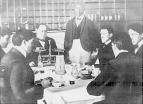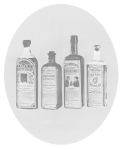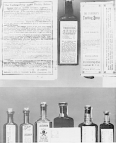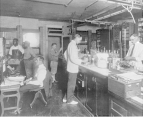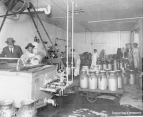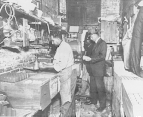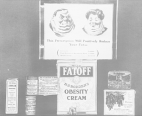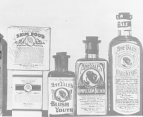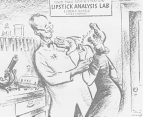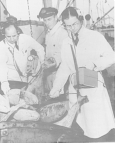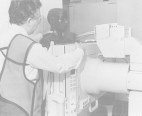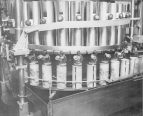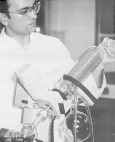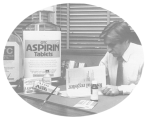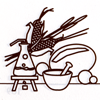 Pure Food and Drugs
Pure Food and Drugs
Concern about the purity of food, drink, and medicines goes back at least to the beginning of recorded history. Regulation of food in the United States dates from early colonial times. Federal controls over the drug supply, namely banning the importation of adulterated drugs, started in 1848.
In the last quarter of the 19th century many attempts were made to enact a national food and drug law. Gradually a coalition developed, including farmers, food processors, state officials, physicians, women's club members, and muckraking journalists. Pressure from this powerful lobby together with public alarm over unhygienic conditions in Chicago's meat-packing plants revealed in Upton Sinclair's novel, The Jungle, and confirmed by government investigators, finally pushed Congress to enact, in l906, both a meat inspection law and the Food and Drugs Act. The law forbade adulteration and misbranding of foods, drinks, and drugs in interstate commerce but contained few specific requirements to insure compliance. Technological changes and adverse court decisions soon made it obsolete.
Thirty years later a drug tragedy in which over 100 people were killed by a poisonous solvent used to dissolve the wonder drug sulfanilamide, greatly dramatized the need to broaden existing legislation and ensure product safety before marketing. The following year Congress passed and President Franklin D. Roosevelt signed into law the Federal Food, Drug, and Cosmetic Act of 1938 which, with major amendments in the last 50 years contains the basic law of the land. Among numerous new provisions, it required manufacturers to provide scientific proof of a new drug's safety before it could be marketed and made dangerous or falsely labeled cosmetics and therapeutic devices illegal.
Enforcement of these laws is the mission of the Food and Drug Administration (FDA), established originally as the Bureau of Chemistry in the Department of Agriculture. Today, as a major regulatory agency of the Public Health Service, the FDA ensures consumers that foods are safe and wholesome; prescriptions and nonprescription medicines, animal drugs, and biologic drugs are safe and effective for their labeled uses; cosmetics are harmless; medical devices are safe; all these products are honestly and accurately labeled and packaged; and that radiation from electronic products does not pose a consumer hazard.
Gallery
In 1902 Dr. Harvey W. Wiley (third from the left), chief chemist at the U.S. Department of Agriculture and the "human catalyst" who helped coordinate the national campaign for pure food and drugs, started research with human volunteers, officially designated the "Hygienic Table," to determine the effects of food preservatives on digestion and health. Overnight the press made the "Poison Squad" a national sensation. Wiley's research showed that such additives as borax, salicylic acid, and formaldehyde were harmful. He became convinced that chemical preservatives should be used in food only when necessary, that the burden of proving safety should fall on the producer, and that none should be used without informing the consumer on the label-basic principles of today's law and regulations.
c. 1905
Before the Food and Drugs Act of 1906 prohibited interstate commerce in misbranded and adulterated foods, drinks, and drugs, thousands of questionable remedies, some containing only harmless and inert preparations but many having narcotic drugs and alcohol, were sold everywhere and to anyone, without restriction. They claimed to cure every disease and symptom. Most labels did not declare ingredients, and warnings against misuse were unheard of. What information the public got about these products came from the physician or pharmacist, from hearsay, or sometimes from bitter experience.
c. 1910
One of the worst patent medicine abuses was the addiction of babies given "soothing syrups" containing varying amounts of morphine, heroin, opium, or laudanum (a mixture of alcohol and opium) to stop their crying. The 1906 law required only that the narcotic and the dose be declared on the label. Several newspaper and national magazines together with the American Medical Association began the fight against the "soothers." Retail druggists pledged to stop selling them over the counter and a federal narcotic law, the Harrison Act of 1914, finally made this illegal.
c. 1910
In 1903 Collier's Weekly launched a sensational campaign to expose the evils of patent medicines and to support federal food and drug legislation. The noted reporter and author Samuel Hopkins Adams wrote more than a dozen articles in his "Great American Fraud" series for that journal. Other famous "muckrakers" aroused public opinion with their articles, editorials, and cartoons in such national magazines as the Ladies Home Journal and Good Housekeeping.
1905
The Food and Drug Administration dates from 1862 when President Lincoln appointed Charles Wetherill as chemist of the new Department of Agriculture. Studies of food adulteration, begun by Wetherill's successors, were greatly expanded when Dr. Harvey W. Wiley became Chief of the Bureau of Chemistry in 1883. One of the Bureau's early laboratories is shown here. After the passage of the Food and Drugs Act in 1906, which forbade adulteration and misbranding of foods, drinks, and drugs in interstate commerce, the Bureau of Chemistry was given the task of investigating violations and preparing cases for the courts. In 1927 a separate law enforcement agency, the Food and Drug Administration, was formed. In 1940 the Food and Drug Administration was transferred to the Federal Security Agency, which in 1953 became the Department of Health, Education, and Welfare. Another reorganization in 1968 placed the Food and Drug Administration in the Public Health Service.
c. 1910
The first 28 food and drug inspectors were selected from over 2,000 applicants in 1907. One of these early Bureau of Chemistry inspectors was John Earnshaw, shown here inspecting a creamery in the Baltimore-Washington area. The adulteration of milk with water and chemicals was one of the common problems. Samples collected by the inspectors were sent hack to the Bureau laboratories for bacteriological and chemical analyses.
c. 1910
Unprocessed foods such as milk, eggs, poultry, and oysters were of particular concern because of unsanitary conditions in many establishments and the primitive nature of refrigeration. Here, inspector John Earnshaw examines eggs. In order to ensure uniform enforcement of the law, an Inspector's Manual was issued in 1908. This manual contained a checklist of conditions to be reported, such as sanitation, the health of employees, and the use of chemical preservatives and colors, matters which still concern the Food and Drug Administration.
c. 1910
After the passage of the 1906 law many nostrum vendors continued manufacturing and selling their products but changed their advertising tactics. They did not advertise their products in newspapers and magazines as patent medicines, but as apparently innocent ingredients among others in a "prescription" or recipe which the readers were urged to have "filled" at the nearest drugstore. Many of these "prescription fakes" included diet products such as "Fatoff," which made claims about curing obesity. Diet aids continue to he one of the biggest on-going areas of health fraud in the United States.
c. 1910
Cosmetics were not subject to the 1906 law, but some beauty products like Mme. Yale's Hair Tonic were considered drug preparations. The courts determined that they were misbranded by their claims to cure falling hair and dandruff, remove wrinkles, and feed the skin. The Food, Drug, and Cosmetic Act of 1938 expanded the 1906 law to include all cosmetics.
c. 1910
The 1938 law considerably expanded consumer protection, but consumers continued to be guinea pigs for the many new chemicals that were being added to food and cosmetics. The law prohibited poisonous substances but did not require showing that food or cosmetic ingredients were safe. In 1951-52, a select committee of the House, chaired by Rep. James Delaney of New York, held extensive hearings on how to handle problems arising from chemicals in food and cosmetics. From these and later hearings came 3 major amendments to the drug law: the Pesticide Amendment (1954), the Food Additives Amendment (1958), and the Color Additives Amendment (1960). This cartoon expresses public concerns about color additives in cosmetics and the need for scientific investigations to establish safety. The caption reads: "No, Doris, lips that touch Fire Plug Pink shall never touch mine."
c. 1960
The protection of the public against unnecessary exposure to potentially hazardous radiation was a function of the FDA's Bureau of Radiological Health. The first large scale radiological examinations of food were made in 1954 when the FDA began round-the-clock checking of frozen tuna from Pacific waters exposed to fallout from atomic bomb tests. More than 33 million pounds of the fish were checked with Geiger counters originally designed for civil defense work. Determining the extent of atomic contamination of foods, drugs, and cosmetics, and workable procedures for decontamination, were major concerns of the FDA scientists through the 1950s. Based on this experience came the FDA's "total diet" studies which detect and measure many substances in the United States food supply including vitamins and pesticides. In 1983, radiation safety became the responsibility of the FDA's Center for Devices and Radiological Health.
c. 1954
Researchers at the Food and Drug Administration's Center for Devices and Radiological Health develop a method to calculate radiation doses from medical fluoroscopy. Ensuring the safety, efficacy, and proper labeling of medical devices for human use is the major function of this Center. Even before World War I, the Food and Drug Administration was taking action against quack drugs and devices which claimed to he radioactive. The Public Health Service became concerned about workers who contracted cancer from radioactive luminous paint they applied to watch dials and the increase in overdosage with diagnostic X-rays. With the development of electronic technology came new products such as televisions, microwave ovens, and lasers which could emit harmful radiation. Congress passed a Comprehensive Radiation Health and Safety Act in 1968 to deal with such problems. In 1971, the product-related activities of the Public Health Service's Bureau of Radiological Health were transferred to the Food and Drug Administration, while its environmental activities were shifted to the new Environmental Protection Administration.
c. 1985
Following reports during 1979 that over 100 infants had been made seriously ill because of the lack of chlorides in two soy-based infant formulas, Congress passed the Infant Formula Act of 1980. This new law authorized the Food and Drug Administration to adjust nutritional standards for infant foods to conform with the best available scientific knowledge. Manufacturers are required to test their products periodically and report promptly to the Food and Drug Administration when they do not meet the official specifications.
c. 1987
The regulation of vaccines, serums, and other biologic products, which includes the establishment of product standards and the licensing of manufacturers, previously carried out by the National Institutes of Health was transferred to the FDA's Bureau of Biologics in 1972, and in 1987 to the FDA's Center for Biologics Evaluation and Research which became responsible for the continued safety, purity, potency, and efficacy of these products.
c. 1980
From its beginning FDA has been concerned with the health of animals, an important source of human food and clothing. In 1984 the FDA's Center for Veterinary Medicine assumed responsibility for developing policies regarding the safety and efficacy of animal drugs, feed additives, and devices. The Center also evaluates for safety and efficacy any proposed and marketed drugs, feed additives, or devices for animal use.
c. 1980
Studying the biological effects, especially any adverse health effects, of potentially toxic chemical substances in our environment is the major job of the FDA's National Center for Toxicological Research. Created by a presidential order in 1972, this Center also emphasizes the development of improved methodologies and tests for evaluating the safety of chemical toxicants.
c. 1980
An important function of the FDA is to develop and implement standards for the safety and effectiveness of all over-the-counter drugs. These nonprescription drugs are generally regarded as safe for the consumer to use by following the required directions and warnings on the label.
1982



